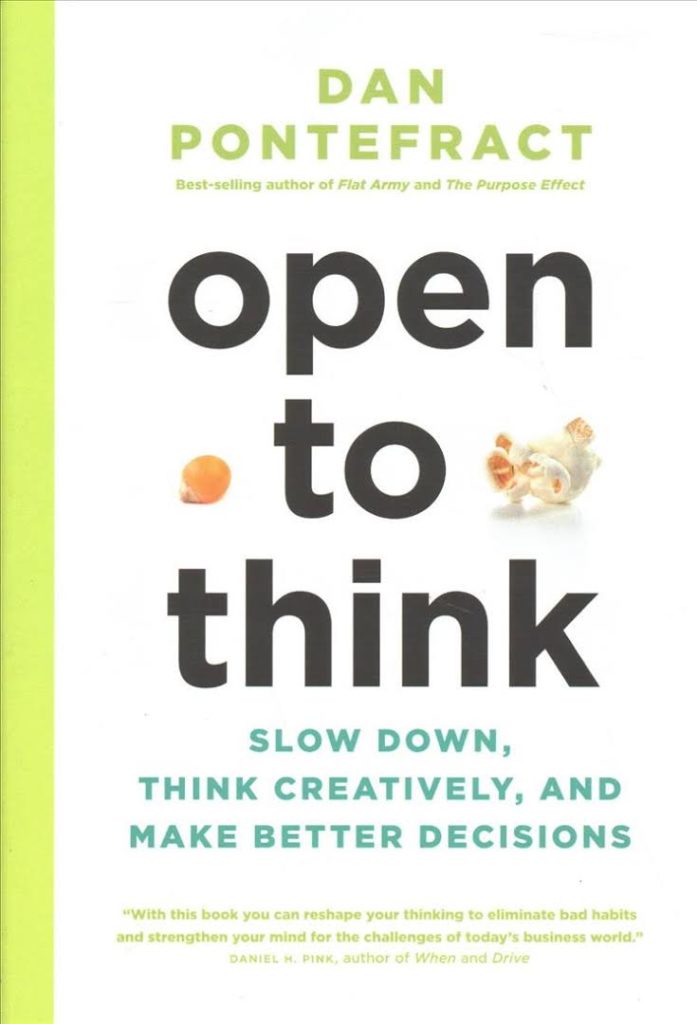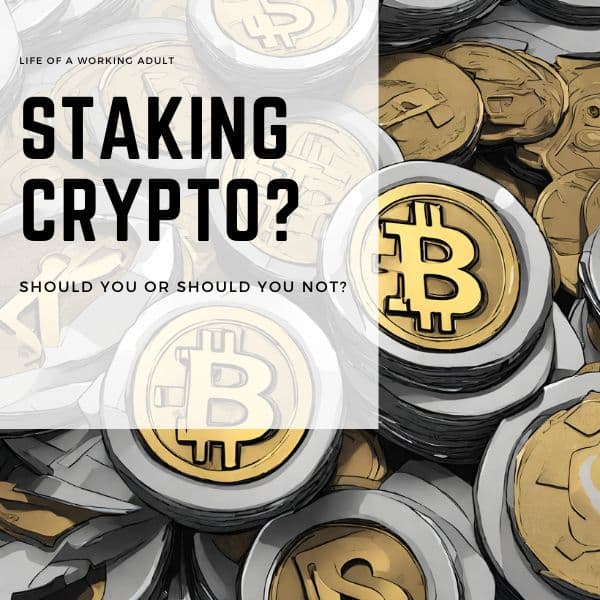In this book – Open to think, Dan Pontefract explains how his “dream, decide, do” system works. He also provides real-life examples of “open thinkers” whose accomplishments stem from their deliberative cognitive practices.
This book was part my recommended eLearning program. Hence, I decided to write a short review of what I thought about this book.

Summary: Open to think – Slow down, think creativity, and make better decisions
These days people are busier than ever. We have little time to do anything well. That basically means we do not have time to think things through most of the time. So most of the time, we tend to rush to conclusions, accept misinformation, skip nuances and trust shallow assumptions. Pontefract instead asks us to pause to ponder.
“Open thinking” is a cyclical process in which creativity is encouraged, critiquing leads to better decisions, and thoughtful action delivers positive, sustainable results. It’s a return to balance between the three components of productive thought: dreaming, deciding, and doing.
Open to Think
According to this book, society has lost its grip on what matters – the ability to think. Clear thinking is now an increasingly rare commodity. I tend to agree with the author.
In the book, he introduces how open thinking balances reflection and action, how to welcome new ideas, the three core elements of open thinking – creative, critical and applied thinking, how it improves decision making, and implementation of open thinking.
How open thinking balances reflection and action
| Open thinking balances reflection and action. If these elements don’t align, three bad habits can take hold: 1. “Indifferent thinking”: Habit that traps people into staying with their current methods and thought processes no matter how self-defeating they may be. 2. “Indecisive thinking”: Those who have a hard time making decisions constantly mull over what to do or not do. They fall prey to “endless dreaming,” a state of mind that strategic management expert H. Igor Ansoff calls “paralysis by analysis.” 3. “Inflexible thinking”: Many people are uncomfortable to make conscious thinking about what they believe or the actions they’re going to take. They avoid analyzing their own processes and just plunge ahead. They “choose activity over a weighted blend of ideation, pause, consideration and response… The act of doing becomes the most important thing.” |
3 core elements of open thinking – Creative Thinking, Critical Thinking and Applied Thinking
Pontefract also explains that open thinkers are always receptive to new ideas, innovative concepts and view accepted dogma with scepticism. Open thinkers acknowledge what they don’t know, and they are willing to learn. The pursue discovery even if the new knowledge might upset them or blast apart their current world view.
Open thinking has 3 core elements – Creative thinking, critical thinking and applied thinking.
Creative thinking
Creative thinking covers “ideation and reflection,” which lead to better ideas. Open thinkers are willing to wander and take the time they need to think things through. They make time for daydreaming. When you dream, you stop and observe. You spend time thinking. You get creative. Daydreaming helps you get a different perspective of things, and helps you figure out new solutions and processes.
Question: Why do people tend to apply competition, rather than collaboration instructively?
For an aspiring or practicing open thinker who wants to pause and reflect, time becomes the most valuable commodity. Don’t exploit your time – as most organizations want you to do. Explore it. Set up a quality time-management system to protect your time.
Critical thinking
Critical thinking centres around analysis and judgment. It generates better decision making. Everyone has cognitive biases that get in the way of clear and logical thinking. We need to learn our biases, and compensate for them. We should try these. Challenge the way you think and the conclusions you reach. Seek new ideas and information. Welcome opinions from both sides of the argument.
“Better thinking is hard, not easy. Better thinking takes time, not haste. There is not shortcut.”
Open to think
Collaborating with your colleagues helps promote open thinking. Ask people you trust and respect for their suggestions and advice. The more people you involve in your decision making, the better your decisions will be – within limits.
As you think through new approaches and concepts, realise that failure is also part of the learning experience. It isn’t negative if you take the time to evaluate your mistakes.
Applied thinking
Applied thinking means acting on your decisions. Applied thinking actualises your “commitment to execute a decision.” It doesn’t focus on “what” to do, but on “how” to do it. To get the results you want, the “how” always counts.
Inspire people to develop their own solutions. Support the solutions they suggest and implement them accordingly. Do however, take note that external conditions changes constantly, so remember to be flexible and supportive. Demonstrate empathy if they struggle at first to find solutions.
“Thinking – like eating is something we all do. In fact, we are all constantly thinking. But as with eating, there are both healthy and unhealthy habits.”
Open to think
Also, keeping everyone looking super busy all the time may generate a veneer of efficiency, but busy work in itself just isn’t efficient. You want your employees to think and reflect on their actions. If everybody is just busy moving, that can’t happen. Help your employees and colleagues focus on the long term, not the short term.
Read also: Presenteeism – Why Should You Care?
10 Principles to exercise open thinking
- Allow yourself plenty of time to think clearly and comprehensively. Never rush your thinking. Open thinking is a “slow thinking movement.”
- Too much thinking, rethinking and re-rethinking can become self-defeating. So can too much collaboration. After careful thought and conversation, move ahead decisively.
- Never take action just to take action. Be thoughtful about what you do and decide what not to do.
- Be flexible in your thinking. Let knowledge shape your ideas and opinions.
- Write down your best thoughts. Idea flow is a continuing resource.
- Be systematic and organized in everything you say and do. Scatterbrains are ineffective thinkers and planners.
- You can’t be creative if you’re always busy. Take breaks to refresh yourself and create time for new ideas to emerge.
- Dig for information to enable proper analysis and informed decision making. Never be hasty. Don’t settle for insufficient data. Lisa Helps, mayor of Victoria, British Columbia, thinks people often leap to premature conclusions after reading “three things on Facebook.” She faces each situation ready to take in meaningful information.
- Maintain your focus. Don’t succumb to time-wasting distractions.
- As an open thinker, include time to dream, decide and do every day.
My Take
The book was overall a pretty good book. Open to think makes you think about your current thinking process. He gives you his take of his open thinking model, and examines each component in detail. He brings you insights and stories from interviews taken with a wide variety of people and organisations. I like the way he divided each thinking component for the individual and for the organisation. It makes you feel that this thinking approach can be adopted by anyone.
Throughout the book, Pontefract also poses a number of pertinent questions, which makes the book engaging. One thing I feel the book lacks is the how to build the foundation of open thinking, so that open thinking can take place in an organisation. It sounds great in theory, but without the necessary fundamentals, like the right corporate culture and buy-in from the people, incorporating it will take a lot of struggle for it to properly take root and grow.
My two cents
Overall, I agree with his views. Everything is too fast paced these days. At times when I get caught up in things, I too forget to pause to ponder about the way we do things anymore. We need to make that time to reflect and determine whether the current thought process is effective.

Have you stopped recently to consider what it means to think openly?
Have you stopped recently to consider what it means to think openly? This was the basis of our basic education at school and the mantra from birth. From birth, we are trained to be independent, confident and open thinkers. What has happened to that?
I remember being all hyped up when I landed my first job after graduating. The sheer excitement of getting my first pay check, that first big client meeting, the first performance review, the first time I led a big meeting… but after several years in the field, I realised that things have changed. Where once I could openly think and give out ideas, these have been squashed by fear and corporate norms.
And this I believe, holds true for most experienced people. As I look around, I notice that people begin to hold back spreading their new ideas or alternative possibilities. A few reasons stand out. It might mean more work for you, or even reprimands for challenging the status quo. If the culture is so thick with rigidity and power, speaking up might even put you in the firing line Or perhaps if the culture is too inflexible, a good idea will just take too long to get to fruition.
This causes disengagement from the thinking process, and it crushes one’s inventiveness and creativity. And time will just fly by. The worst part is at the end of the day, we even forget what we wanted in the first place.
“At the centre of your being you have the answer; you know who you are and you know what you want.”
Lao Tzu
Take time to pause to reflect
Now as I take the time to reflect, I recall the first few years of my working career. I always tried to move forward. I rarely stopped, rarely paused, rarely reflected. There were wins and loses. But one thing I thought I knew for sure, if I stopped, I automatically will fail and fall behind. That was my understanding – be fast and move forward at any cost. That has caused me to be stressed and distressed. Looking back, I wished I had taken the time to pause, think and reflect. Things could have been really different.
Read also: [Opinion] Why Work?
But it’s not me that only feeling this way because when I look around, I notice the same pattern in many people around me. We all want fast and instant gratification. “I want it now!”. “Do it now!” seem to be the new normal.
A society that’s too fast paced?
Society is now caught in a chaotic, frenzied spiral of faster living. It’s an addiction. People are chasing money, power, success and a wilder, faster pace of life. What is supposed to free us ends up enslaving us. Whatever the lure, it seems so good, so positive, so helpful, so harmless… that’s the paradox of addiction. Like any addiction, people are out of control in their behaviours, feelings and thinking, yet while in it, they believe that they are normal. And so we continue to hurtle into that chaos.
Technological advances have taken away our attention and creativity
I have seen changes in my attention span and thinking. Technological advances were supposed to free up our time, so that we can spend more time for creative thinking. But it has achieved the opposite effect. It has instead enslaved us, taking up all our attention and creativity. It’s feels as if dumbing down has taken place.
The mass flood of information has made us to have lesser time to reflect on anything. Notice that each time you receive a notification on your phone no matter what you are doing, you can’t help but sneak a peak? We have been dominated by the need to always be available. We have are now enslaved to the gadgets. Multi-tasking stimulates chaos and destroyed our concentration and attention. That’s why I like Apple’s Focus function that was introduced in iOS 15.
Read also: The Apple iOS 15 update is here!
To close
Pause, reflect, know your biases, question everything, be open to new ideas, be agile, flexible, and ultimately make time to day dream.
“The illiterate of the 21st century will not be those who cannot read and write, but those who cannot learn, unlearn and relearn.”
Open to think
About the book and author
“Open to think” is the winner of the 2019 GetAbstract International Book of the Year.
Dan Pontefract is a Canadian businessperson, a leadership strategist, keynote speaker, best-selling author and he founded the Pontefract Group in 2014. He is one of the most respected people in his field internationally, both because of his practical experience and his academic work (in addition to everything else, he teaches at University of Victoria).
Open to think is available on Kinokuniya Malaysia retailing at RM125.69 or RM113.12 for Kinokuniya Privilege Card Members.




